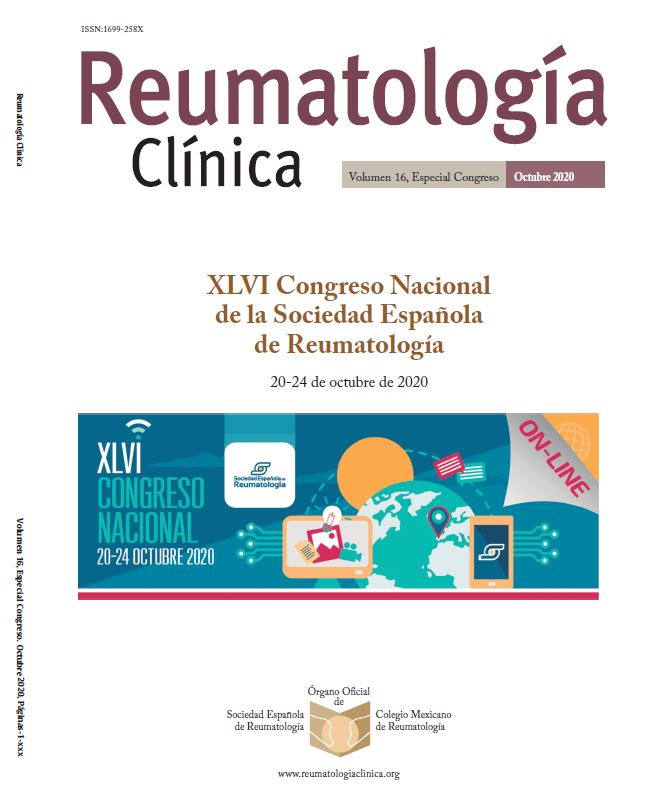P202 - Validation of a simplified Spanish tool for semi-automatic quantification of sacroiliac inflammation by magnetic resonance in spondyloarthritis (s- SCAISS)
1Rheumatology Department; 2Radiology Department. Hospital Universitario Fundación Alcorcón. 3ALCE ingeniería. Madrid.
Introduction: The use of these quantification methods are restricted to clinical trials, since their use in clinical practice is limited due to their complexity, need for trained personal, and prolonged procedural time. The development of computers and data processing software has led to significant advances in methods for image analysis. With the objective to improve quantification of sacroiliitis maintaining a practical perspective, our group developed SCAISS, a semi-automated method to measure bone marrow edema (BME) in MR images from sacroiliac (SI) joints, combining semi-axial and semi-coronal slices. The 2009 ASAS definition of active sacroiliitis was based on standard semi-coronal slices only, perpendicular semi-axial slices being considered but optional. The 2016 and 2019 revision did not address technical issues of MRI protocols. We hypothesized a simplified SCAISS (s- SCAISS) method using only a standard semi-coronal slices.
Objectives: To analyze the validity and reliability and feasibility of a simplified Spanish tool for semi-automatic quantification of sacroiliac inflammation by magnetic resonance in spondyloarthritis (s- SCAISS) using a standard semi-coronal scan instead of combining semi-axial and semi-coronal slices.
Methods: The s- SCAISS was designed as an image-processing software. We performed the following analysis: (1) three readers evaluated SI images of 23 patients with axial SpA and various levels of BME severity with the s-SCAISS and SCAISS, and two non-automated methods, SPARCC and Berlin; (2) 20 readers evaluated 12 patients images, also with the three methods; (3) 203 readers evaluated 12 patient images with the Berlin and the s-SCAISS and SCAISS. Convergent validity, reliability and feasibility were estimated in the first two steps and reliability was confirmed with the third.
Results: The interobserver reliability (ICC and 95%CI) in the three observers’ study was: s-SCAISS = 0.69 (0.490-0.845); SCAISS = 0.770 (0.580-0.889); Berlin = 0.725 (0.537-0.860); and SPARCC = 0.824 (0.671-0.916). In the 20 observers’ study, ICC was: s- SCAISS = 0.66 (0.478-0.863); SCAISS = 0.801 (0.653-0.927); Berlin = 0.702 (0.518-0.882); and SPARCC = 0.790 (0.623-0.923). In the 203 observers’ study, ICC were: s-SCAISS = 0.699 (0.53-0.887); SCAISS = 0.810 (0.675-0.930), and Berlin = 0.636 (0.458-0.843). Spearman correlation coefficient (tested in the 20 observers’ study) between s- SCAISS _BERLIN was r = 0.712 and s- SCAISS_ SPARCC was r = 0.779 and s- SCAISS _SCAISS was r = 0.90. Similar results showed SCAISS_BERLIN and SCAISS_ SPARCC (r = 0.729 and 0.840), respectively. The intra-observer reliability, tested in the 20 observers’ study in three patients, was tested with the Pearson correlation coefficient (r) (95%CI) and was similar across methods, as follows: s- SCAISS = 0.926 (0.872-0.958); SCAISS = 0.965 (0.938-0.980); Berlin = 0.838 (0.725-0.907); and SPARCC = 0.949 (0.911-0.971). Median time (interquartile range) employed in the reading procedure was 14 (13) seconds for the s-SCAISS, 28 (14) seconds for the SCAISS, 14 (9) for the Berlin score, and 94 (68) for the SPARCC.
Conclusions: The simplified SCAISS (s-SCAISS) using only a standard semi-coronal slice permits a valid, reliable, and fast calculation of overall BME lesion at the SI joint. Also s-SCAISS showed a good convergent validity with SCAISS, BERLIN and SPARCC.







